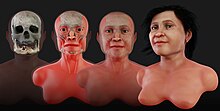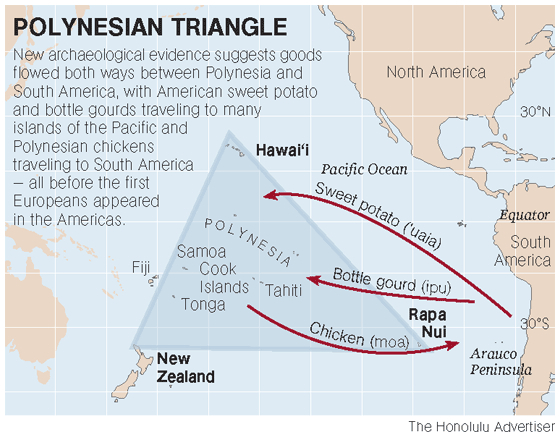CROSS-LINK: AP Legacy Course World History Standard 
Period 1:2 The Neolithic Revolution and Early Agricultural Societies

Topics on the Page
New Research on Human Migration to the Americas
The Older Land Bridge Theory
Examples of Early Human Remains in North America
- Kennewick Man
- Eve of Naharon
The Clovis Theory
Polynesian Explorations
Confronting Eurocentrism in Ancient American History

Atlas of Human Journey provides an interactive world map with video segments on the spread of humans from 200,000 BCE to 10,000 BCE from "The Genographic Project" and National Geographic.
This interactive map shows US Migration over 2 centuries starting at 1820 and ending at 2013.
New Research on Human Migration to the Americas
New Map of Alaska's Ancient Coast Supports Theory That America's First People Arrived by Boat, Science (May 30, 2018)
- Most archaeologists think the first Americans left Beringia, the now-drowned land between Siberia in Russia and Alaska, about 16,000 years ago—likely before the ice-free corridor opened—and traveled by boat down the Pacific coast. But direct evidence for such a journey is lacking.
- By measuring the concentration of beryllium-10, researchers can calculate how long the rock has been out in the open.
Graphic of the land bridge that brought travelers from Siberia to North America

Archaeologists generally agree humans populated the Americas around 14,500 years ago.
- However, there is evidence of humans in Monte Verde, Chile 15,000 years
- Evidence of humans in Florida, 14,500 years ago
New research questions the Land Bridge Theory This research includes the idea that people came to the Americas by boat from Asia.
 Did First Americans Take a Ride on the Kelp Highway? National Geographic (2017)
Did First Americans Take a Ride on the Kelp Highway? National Geographic (2017)
 The Kelp Highway
The Kelp Highway
Prehistoric Highway into the Americas
First Humans Entered the Americas Along the Coast, Not Through the Ice
Graphic Displaying the Land Bridge from 21,000 BC to today

The Older Land Bridge Theory
The Land Bridge theory proposes that people migrated from Siberia to Alaska across a land bridge that spanned the current day Bering Strait.
- The first people to populate the Americas were believed to have migrated across the Bering Land Bridge while tracking large game animal herds. Most textbooks cite this theory.
- Fossils found and carbon dated from the Bluefish Caves on the Bluefish River in northern Yukon near Alaska border
 |
| Paisley Caves, above Summer lake plain, Oregon |
- Evidence from the 1990s shows human habitation in Monte Verde, Chile, dating back to 14,500 years ago - a millennium older and much further south than what was previously thought to be the first people in the Americas. How they got there is open to debate.
- Findings from Meadowcroft Rockshelter in Pennsylvania, Page-Ladsen flake tools in Florida, and coprolites from Paisley Cave in Oregon suggest people were in these locations some 14,500 BP.
- Another claim for human settlement in the Americas is the Topper Site in South Carolina, dating back to about 15,000 BP
 Human Numbers Through Time shows the growth of world population from the Common Era Year 0 to the present.
Human Numbers Through Time shows the growth of world population from the Common Era Year 0 to the present.
 Click here for a video from the Smithsonian "Across Atlantic Ice."
Click here for a video from the Smithsonian "Across Atlantic Ice."
Examples of Early Human Remains in North America
Kennewick Man

- Discovered in Kennewick, Washington in 1996. Using radiocarbon dating scientists believe it to be from around 9,000 years BP, making it one of the most complete ancient skeletons ever found.
- The remains of the Kennewick Man are genetically similar to people from Coastal Asia, signifying that both migration across the Bering Land Bridge and migration by boat from Pacific Islands may have happened simultaneously
- Originally controversy over discovering party classifying it as a "Caucasoid" skull when in reality this was not the case.
- The link about the Kennewick Man also details a modern Native American tribe's struggle to reclaim ownership of the Kennewick Man’s skeleton so that it can be given a proper Native Burial.
Eve of Naharon

- Skeleton of a 20-25 year old human female found in Tulum, Mexico. Carbon dated to be from approximately 13,600 years BP.
- Arturo Gonzalez, co-director of the discovery team, explains that the bone structure of the skeleton is more consistent with that of people from Southern Asia than that of people from Northern Asia.
Clovis Theory
Clovis Spear Points, from British Museum

The Clovis First Theory Is Put to Rest at Paisley Caves, July 2012.
Out of Asia from the University of Cambridge (2014) discusses the sequencing of the genome of the earliest complete skeleton found in North America, strongly indicating that the Clovis culture originated in Asia.
Debunking the Clovis First Theory from the New York Times (2014) addresses the possibility that people arrived in Brazil as early as 22,000 years ago, about 10,000 years earlier than the Clovis culture.
Dennis Stanford discusses Clovis culture
Reasons for the Clovis Migration state that they would be able to find a food source in the America and they were hunter-gatherers looking for food.
Polynesian Explorations
Sail plan of the Hōkūleʻa, a waʻa kaulua or voyaging catamaran

 Did Polynesian Voyages reach Americas before Columbus?
Did Polynesian Voyages reach Americas before Columbus?
Experts have come to hold the view that Polynesian seafaring explores came into contact with natives and introduced chickens into south America prior to the arrival of Columbus.

Polynesian Seafarers Discovered America Long Before Europeans, Says DNA Study
Sweet Potato Theory
This article expounds upon evidence and argumentation developed in a study of sweet potato crops in South America and Polynesia.
The study argues that since sweet potatoes are indigenous to the Andes Mountains, the only way Polynesians could have gotten seedlings to grow on various Polynesian islands was by "discovering" the Americas and bringing sweet potato back to Polynesia.
An alternative view accounts for the sweet potato theory and states that the sweet potatoes traveled through a marine current and not with the Polynesians.
In addition, supposed trade routes between Polynesia and South America predate any European contact.
Chickens
Chickens Tell the Tale of Human Migration Across the Pacific
American and Polynesian societies likely came into contact with each other around 1200 AD which is before Columbus as shown by evidence of genetic mixing in humans from that time period.
 VIDEO
VIDEO
Video discusses how Polynesian seafaring developed and operated. Which allowed them to transverse thousands of miles across the ocean effectively, long before Europeans.
 Confronting Eurocentrism and the Whitewashing of History in Ancient American History
Confronting Eurocentrism and the Whitewashing of History in Ancient American History
(Al Jazeera - The Legacy of Columbus Day)
While the voyages of Columbus come much later in the context of "the peopling of Americas" it feels important to include this as the thread at the end of this conversation. Much of the skepticism around some of the theories of early American migration and settlement reflects the broader trends of Eurocentrism in the telling of this history. Some people are skeptical of the theories that early African and Polynesian peoples came to the Americas before Europeans because of the underlying racism and eurocentrism that feeds the narratives that construct much of the mainstream ideas of "ancient history". It is important to think about the stories and myths we tell ourselves, like Columbus Day, that came later but are still incredibly relevant to bringing in a critical lens to the ways in which we conceive this kind of history. It is important to not just recite the facts, but also challenge the underlying assumptions and cultural beliefs that privilege certain facts and certain versions of this historical framework.
(Study Casts Doubts on Polynesian Theory of Contact before Europeans)
Narratives like this reflect some of the problematic trends touched on in the paragraph above. The author is dismissive that people in sea-faring canoes could have made a "pre-Columbian" voyage to South America and beat the Europeans to it. The entire narrative, despite this being on a timeline way before Columbus still gets framed around one Italian genocidal explorer as being the major turning point in this history. These early Polynesian contacts are "pre-Columbian" because they are not seen as majorly important in the same way by the established narrative of a European "discovery" of a "New World". One can clearly see the ways in which this centers the story back upon the supposed genius of Europe, making the story about Europe and all its marvels even when there is strong evidence that other societies were interacting with the so-called "Americas" way before any Europeans ever came into contact. The author of this article is dismissive and overtly biased in the version of the story he prefers. This piece is just case in point of the need to be skeptical of who is telling the story rather than only narrowing in on the what of the story. The status quo is self reinforcing and is in many ways casting skepticism on essential new understandings that would help us reconstruct a more accurate and wholesome idea of world history.
Indigenous peoples find the Americas before Christopher Columbus
Despite everyone believes that Christopher Columbus and the European voyage discovered the Americas, there is evidence proving that the Native Americans had settled there before it was claimed to be discovered. This is clear that the Eurocentrism point of view has an immense impact on the way that history is taught and interpreted in schools today. This article proves that historians often ignore vital pieces of information to support the Eurocentric interpretation of the discovery of the Americas.
Comments (0)
You don't have permission to comment on this page.